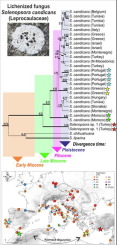当前位置:
X-MOL 学术
›
Mol. Phylogenet. Evol.
›
论文详情
Our official English website, www.x-mol.net, welcomes your feedback! (Note: you will need to create a separate account there.)
Spatio-temporal formation of the genetic diversity in the Mediterranean dwelling lichen during the Neogene and Quaternary epochs.
Molecular Phylogenetics and Evolution ( IF 4.1 ) Pub Date : 2019-12-07 , DOI: 10.1016/j.ympev.2019.106704 Zuzana Fačkovcová 1 , Marek Slovák 2 , Peter Vďačný 3 , Andrea Melichárková 1 , Judita Zozomová-Lihová 1 , Anna Guttová 1
Molecular Phylogenetics and Evolution ( IF 4.1 ) Pub Date : 2019-12-07 , DOI: 10.1016/j.ympev.2019.106704 Zuzana Fačkovcová 1 , Marek Slovák 2 , Peter Vďačný 3 , Andrea Melichárková 1 , Judita Zozomová-Lihová 1 , Anna Guttová 1
Affiliation

|
Genetic patterns of lichenized fungi often display a mosaic-like and difficult to interpret structure blurring their evolutionary history. The genetic diversity and phylogeographic pattern of a mycobiont of the predominantly Mediterranean dwelling lichen Solenopsora candicans were investigated on the base of extensive sampling (361 individuals, 77 populations) across its entire distribution range. We tested whether the genetic pattern of S. candicans mirrors paleoclimatic and paleogeological events in the Mediterranean and adjacent regions. The divergence time estimates indicated a Tertiary origin for S. candicans, with formation of intraspecific diversity initiated in the Late Miocene. The distribution of the most divergent haplotypes, mostly of a pre-Pleistocene origin, was restricted to the eastern or western extremities of the Mediterranean exhibiting Kiermack disjunction. The population genetic diversity analyses indicated multiple diversity centres and refugia for S. candicans across the entire Mediterranean Basin. While the south Mediterranean regions harboured both the Tertiary and Quaternary born diversity, conforming to the 'cumulative refugia' paradigm, the Apennine and Balkan Peninsulas in the north hosted mostly younger Pleistocene haplotypes and lineages. The recent population expansion of S. candicans might have occurred in the middle Pleistocene with a population burst in the Apennine and Balkan peninsulas. The presence of unique haplotypes in Central Europe indicates the existence of extra-Mediterranean microrefugia. This study presents the first comprehensive lichen phylogeography from the Mediterranean region and simultaneously reports for the first time the glacial survival of a warm-adapted lichen in the temperate zone.
中文翻译:

在新近纪和第四纪时期,地中海居住地衣遗传多样性的时空形成。
地衣真菌的遗传模式通常表现出马赛克状且难以解释模糊其进化史的结构。在整个分布范围内广泛采样(361个个体,77个人口)的基础上,对以地中海为主要地衣的地衣Solenopsora candicans的一种真菌生物体的遗传多样性和系统地理学模式进行了研究。我们测试了S. candicans的遗传模式是否反映了地中海及邻近地区的古气候和古地质事件。估计的发散时间表明S. candicans的第三纪起源,在中新世晚期开始形成种内多样性。最不同单倍型的分布,大多数是前更新世起源的,仅限于出现基尔马克分离现象的地中海东部或西部。种群遗传多样性分析表明,整个地中海盆地的S. candicans有多个多样性中心和避难所。地中海南部地区具有第三纪和第四纪生来的多样性,符合“累积避难所”范式,而北部的亚平宁和巴尔干半岛则以更新世的单倍型和谱系为主。最近的S. candicans人口膨胀可能发生在中更新世,亚平宁和巴尔干半岛的人口激增。在中欧,独特的单体型的存在表明了地中海外微区系的存在。
更新日期:2019-12-07
中文翻译:

在新近纪和第四纪时期,地中海居住地衣遗传多样性的时空形成。
地衣真菌的遗传模式通常表现出马赛克状且难以解释模糊其进化史的结构。在整个分布范围内广泛采样(361个个体,77个人口)的基础上,对以地中海为主要地衣的地衣Solenopsora candicans的一种真菌生物体的遗传多样性和系统地理学模式进行了研究。我们测试了S. candicans的遗传模式是否反映了地中海及邻近地区的古气候和古地质事件。估计的发散时间表明S. candicans的第三纪起源,在中新世晚期开始形成种内多样性。最不同单倍型的分布,大多数是前更新世起源的,仅限于出现基尔马克分离现象的地中海东部或西部。种群遗传多样性分析表明,整个地中海盆地的S. candicans有多个多样性中心和避难所。地中海南部地区具有第三纪和第四纪生来的多样性,符合“累积避难所”范式,而北部的亚平宁和巴尔干半岛则以更新世的单倍型和谱系为主。最近的S. candicans人口膨胀可能发生在中更新世,亚平宁和巴尔干半岛的人口激增。在中欧,独特的单体型的存在表明了地中海外微区系的存在。



























 京公网安备 11010802027423号
京公网安备 11010802027423号